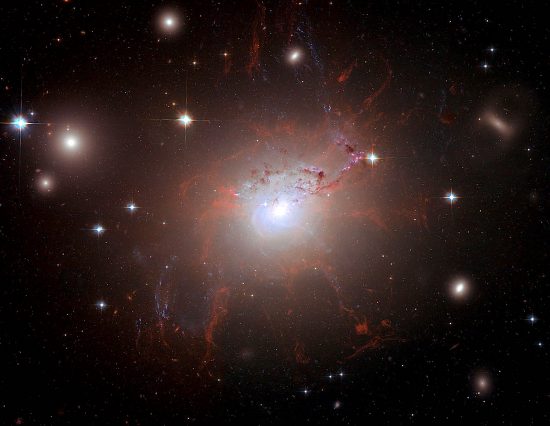
Apr 17, 2019
Galaxy filaments are also called, Birkeland currents.
“Everyday life depends on the structure of the atom. Turn off the electrical charges and everything crumbles to an invisible fine dust, without electrical forces, there would no longer be things in the universe – merely diffuse clouds of electrons, protons, and neutrons, and gravitating spheres of elementary particles, the featureless remnants of worlds.”
― Carl Sagan
Galaxy NGC 1275 is also known as Perseus A. It is a Seyfert galaxy in the center of the Perseus cluster (Abell 426), 230 million light-years away, as astronomers reckon distance. NGC 1275 is a strong radio and X-ray source, producing peculiar emission lines in its nucleus. NGC 1275 was discovered by William Herschel on October 17, 1786.
What makes this galaxy so unique is that multiple strands of material extend outward in light-years-long tendrils. According to astrophysicists, the filaments are examples of “ionized hydrogen”, or electric charge carriers. The hydrogen atom is composed of one electron and one proton, so ionization reduces it to individual nucleons, or plasma. Since electricity is generated by charged particles in motion, the filaments are transmitting electromagnetic energy across vast distances. What holds these “transmission lines” together?
According to recent studies, the plasma filaments are surrounded by gas that is around 55 million Celsius! The tendrils of electricity are constrained in an electromagnetic field, which is how they retain their structure. The image at the top of the page represents the first time researchers observed details in the individual stands of plasma making up the filaments.
Since the hydrogen in NGC 1275 is ionized, it is defined as a plasma. In an Electric Universe, charge flow in plasma generates electromagnetic fields that constrict the current channel. Previous Picture of the Day articles point out that the constriction is known as a “Bennett pinch,” or “z-pinch.” Pinched electric filaments remain coherent over long distances because they wind around each other without coalescing, something like a twisted pair of electric wires.
It is well-known that Birkeland currents are probably the greatest long-range attractors in the Universe, with a force more about 39 orders of magnitude greater than gravity. Birkeland currents attract each other when they are far apart but repel each other when they are close, resulting in pairs of filaments spiraling around their common axes. This process can repeat, producing “cables” of pairs of pairs and so on.
Electric fields in such galaxy-sized currents accelerate charge carriers to near light speed. An electric field’s strength near an electrically charged object is defined as inversely proportional to the distance between the point and the object. However, according to retired Professor of Electrical Engineering, Dr. Donald Scott, the electric field between Birkeland currents in space falls off with the square root of the distance, increasing the attractive force.
These ideas contrast markedly with those from consensus astronomers. who see filamentation in NGC 1275 because a “…supermassive black hole is blowing out jets of matter at nearly the speed of light.” Chandra X-ray Observatory images, combined with radio information from the Very Large Array, reveal giant “bubbles” supposedly swept out by radiation from a central black hole. However, instead of “bubbles”, the formations are an unmistakable indication that Birkeland currents are “squeezing” plasma and charged dust into z-pinch zones.
Radio lobes, X-rays and filaments are all manifestations of electricity in space.
Stephen Smith












